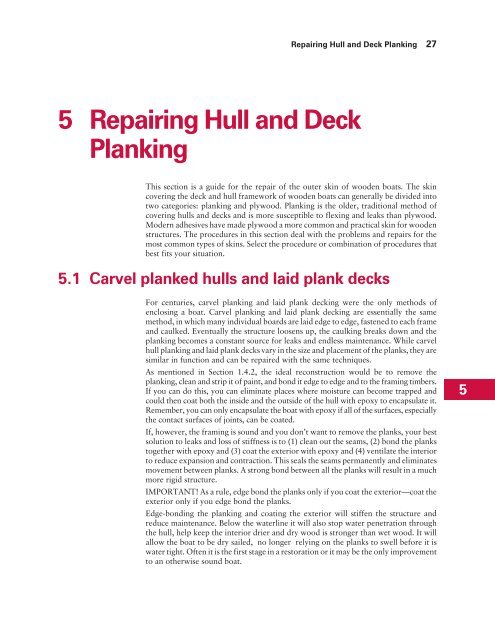Wooden Boat Restoration Repair - WEST SYSTEM Epoxy
Wooden Boat Restoration Repair - WEST SYSTEM Epoxy
Wooden Boat Restoration Repair - WEST SYSTEM Epoxy
You also want an ePaper? Increase the reach of your titles
YUMPU automatically turns print PDFs into web optimized ePapers that Google loves.
5 <strong>Repair</strong>ing Hull and Deck<br />
Planking<br />
<strong>Repair</strong>ing Hull and Deck Planking 27<br />
This section is a guide for the repair of the outer skin of wooden boats. The skin<br />
covering the deck and hull framework of wooden boats can generally be divided into<br />
two categories: planking and plywood. Planking is the older, traditional method of<br />
covering hulls and decks and is more susceptible to flexing and leaks than plywood.<br />
Modern adhesives have made plywood a more common and practical skin for wooden<br />
structures. The procedures in this section deal with the problems and repairs for the<br />
most common types of skins. Select the procedure or combination of procedures that<br />
best fits your situation.<br />
5.1 Carvel planked hulls and laid plank decks<br />
For centuries, carvel planking and laid plank decking were the only methods of<br />
enclosing a boat. Carvel planking and laid plank decking are essentially the same<br />
method, in which many individual boards are laid edge to edge, fastened to each frame<br />
and caulked. Eventually the structure loosens up, the caulking breaks down and the<br />
planking becomes a constant source for leaks and endless maintenance. While carvel<br />
hull planking and laid plank decks vary in the size and placement of the planks, they are<br />
similar in function and can be repaired with the same techniques.<br />
As mentioned in Section 1.4.2, the ideal reconstruction would be to remove the<br />
planking, clean and strip it of paint, and bond it edge to edge and to the framing timbers.<br />
If you can do this, you can eliminate places where moisture can become trapped and<br />
could then coat both the inside and the outside of the hull with epoxy to encapsulate it.<br />
Remember, you can only encapsulate the boat with epoxy if all of the surfaces, especially<br />
the contact surfaces of joints, can be coated.<br />
If, however, the framing is sound and you don’t want to remove the planks, your best<br />
solution to leaks and loss of stiffness is to (1) clean out the seams, (2) bond the planks<br />
together with epoxy and (3) coat the exterior with epoxy and (4) ventilate the interior<br />
to reduce expansion and contraction. This seals the seams permanently and eliminates<br />
movement between planks. A strong bond between all the planks will result in a much<br />
more rigid structure.<br />
IMPORTANT! As a rule, edge bond the planks only if you coat the exterior—coat the<br />
exterior only if you edge bond the planks.<br />
Edge-bonding the planking and coating the exterior will stiffen the structure and<br />
reduce maintenance. Below the waterline it will also stop water penetration through<br />
the hull, help keep the interior drier and dry wood is stronger than wet wood. It will<br />
allow the boat to be dry sailed, no longer relying on the planks to swell before it is<br />
water tight. Often it is the first stage in a restoration or it may be the only improvement<br />
to an otherwise sound boat.<br />
5
















